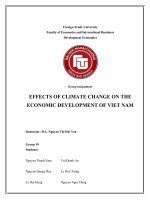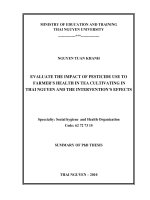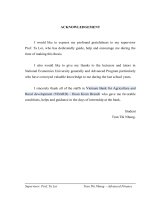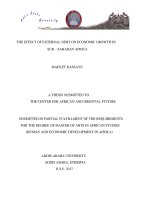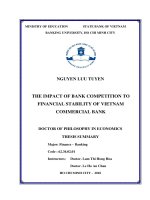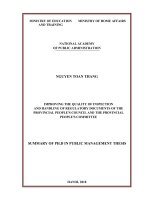Thesis summary: The impacts of external debt to Vietnam’s economic growth
Bạn đang xem bản rút gọn của tài liệu. Xem và tải ngay bản đầy đủ của tài liệu tại đây (444.38 KB, 34 trang )
MINISTRY OF EDUCATION AND TRAINING STATE BANK OF VIETNAM
BANKING UNIVERSITY HO CHI MINH CITY
*****
NGUYEN XUAN TRUONG
THE IMPACTS OF EXTERNAL
DEBT TO VIETNAM’S
ECONOMIC GROWTH
Major: Finance – Banking
Code: 9.34.02.01
THESIS SUMMARY
HO CHI MINH CITY – 2019
MINISTRY OF EDUCATION AND TRAINING STATE BANK OF VIETNAM
BANKING UNIVERSITY HO CHI MINH CITY
*****
NGUYEN XUAN TRUONG
THE IMPACTS OF EXTERNAL
DEBT TO VIETNAM’S
ECONOMIC GROWTH
Major: Finance – Banking
Code: 9.34.02.01
THESIS SUMMARY
ACADEMIC ADVISOR
ASSOCIATE PROFESSOR., PHD. LE PHAN THI DIEU THAO
HO CHI MINH CITY – 2019
ABSTRACT
Vietnam is a developing country and needs huge capital to
build infrastructure and invest in development. However, Vietnam
has a high budget deficit, low rate of income, saving rate and foreign
exchange reserves, resulting in insufficient resources for investment.
Therefore, foreign loans are one of the important resources to offset
the shortage of national development, contributing to catch up with
other countries in the world. However, more and more foreign loans
help the Vietnamese economy grow high because every year the
Government has to spend nearly 25% of its budget to pay debt? How
does foreign capital affect investment, consumption and trade as well
as the economic growth of borrowing countries?
The study examines the impact of external debt on Vietnam's
economic growth using a quantitative approach based on MIDAS.
The results of the study show the positive impact of external debt on
economic growth during the study period. In addition, the variables
of economic openness, exchange rate as well as inflation also impact
on economic growth.
In addition, the study used the VECM quantitative approach
to examine and assess the impact of external debt thresholds on
economic growth. The results show that there is a external debt
threshold in the study period. This is an important basis for making
policy recommendations in the management and use of Vietnam's
external debt in the future.
In summary, the study is an empirical evidence to illustrate
the positive impact of Vietnam's external debt, which provides
policy recommendations to managers and policymakers on this
issue.
Keywords: external debt, economic growth, Vietnam.
CHAPTER 1. INTRODUCTION
1.1. The necessity of the study
From a theoretical and practical point of view, the
relationship between external debt and economic growth is a subject
of much interest to researchers. Theories of external debt and
economic growth focus on explaining this relationship based on
dynamic economic models in open economies, with one side
borrowing external debt to develop the economy. Use external
savings to invest in the economy. This is more and more true for
developing countries when they use abundant external resources and
modern technology to shorten development time in the hope of
escaping poverty, catching up with developed countries, and
increasing incomes for people. However, the other side is the
problem of the efficiency of using loans and increasing the debt
obligations in the future when increasing foreign loans for
investment. This brings risks to the borrowing countries in the
process of economic development as countries borrow heavily from
outside will lead to a buildup of rising interest payments resulting in
reduced investment, reduce social welfare. The question is whether
increasing external debt will increase economic growth or vice versa
as debt obligations increase. In other words, external debt can have
a negative impact on economic growth due to the accumulation of
debt obligations, which makes countries unable to pay their debts.
How does this issue in Vietnam during the open period of
implementing economic reform is a matter of concern for research.
1.2. Background of the study
Studies by Cohen (1993), Deshpande (1997), Krugman
(1998), Sachs (1989), Chowdhury (2001), Pattillo (2004) ...
supported this theory through a number of empirical studies. The
high level of external debt brings uncertainty to the economy due to
the inefficient allocation of capital, focusing on short-term and highrisk projects. However, studies by Frimpong and Abayi (2006),
Daud et al. (2013), Korkmaz (2016) show that the positive effects of
external debt on economic growth reinforce the basis for mentioned
above. Quantitative studies mainly use VECM, ARDL, GMM
models ... with variables of the same frequency (Winston and
Chrystol, 2010). For empirical studies on the impact of external debt
on Vietnam's economic growth, Nguyen Hoang Bao and Doan Kim
Thanh (2009), Nguyen Huu Tuan (2012) and Nguyen Ngoc Thach
and Tran Thi Kim Oanh (2016) using the VECM, GMM models are
consistent with previous studies on external debt. However, studies
on Vietnam have a small number of observations (less than 30
observations) or a varied study period. Based on the abovementioned theoretical and practical analyzes, the thesis found no
study on the impact of external debt as well as some macro variables
(openness, exchange rates, inflation) to Vietnam's economic growth
based on the combination of different frequency data in the research
model. Previous research models mainly used the ARDL, VECM
model for variables with the same frequency (Moore and Thomas,
2010). Therefore, studying the impact of external debt on Vietnam's
economic growth on the basis of combining variable frequency
studies with the MIDAS method is the research gap of the thesis.
1.3. Objectives of the study
The overall objective of the thesis is to assess the impact of
external debt on Vietnam's economic growth by quantitative
research model. To achieve the above objectives, the thesis will
focus on two specific objectives:
(i) Empirical assessment of the impact of this external debt on
Vietnam's economic growth by quantitative models with
macroscopic data published publicly by international organizations.
(ii) Analyze the relationship between external debt and economic
growth to determine the external debt threshold for Vietnam.
1.4. Scope of the study
The subject of the thesis is the impact of external debt on
Vietnam's economic growth in the period 2000-2016, data are
collected quarterly.
1.5. Methodology and data of the study
To assess the impact of external debt on economic growth from
a quantitative perspective on these two research questions, the thesis
uses two research models:
(i) Ghysels et al. (2002, 2006) used the estimation of the linear
effects of external debt on economic growth. MIDAS (Mixed-Data
Sampling) has the advantage of evaluating input time series data at
different frequencies through linear regression.
(ii) Estimation methods using the Vector Error Correction
Model (Johansen) (1991) were used in the thesis to assess the impact
of the external debt threshold on economic growth. The VECM
model was developed from the Vector Autoregressive Model (VAR)
based on the addition of error correction components to the model.
Data used in the study are macro data published by international
organizations such as WB, IMF, ADB and GSO.
1.6. Results and novelty of the study
Empirical research on the impact of external debt on Vietnam's
economic growth shows that: (i) positive impacts of external debt on
Vietnam's economic growth; (ii) the existence of Vietnam's external
debt threshold; (iii) In addition, other factors such as openness of the
economy, inflation, exchange rate also affect the economic growth
of Vietnam. Compared with previous studies of the same topic, the
thesis has new contributions as follows:
Firstly, empirical research using the MIDAS model allows
data to be combined at different frequencies without missing
important information such as other models when referring to
variables at the same frequency, contributing Updated research data
due to some years of external debt not updated quarterly data. The
results show that the positive impact of external debt on Vietnam's
economic growth in the period 2000-2016, compared to previous
research on this issue by Nguyen Hoang Bao and Doan Kim Thanh
(2009) give negative results.
Secondly, the thesis assessed the impact of the external debt
threshold on Vietnam's economic growth based on the existence of
this debt level based on the VECM model with the dummy variables
as exogenous variables. The empirical results show that the debt
level has a significant and significant impact on the short term
growth as well as the positive impact of external debt on long-term
growth. Compared to previous studies on the nonlinear relationship
between external debt and Vietnam's economic growth, Nguyen Huu
Tuan (2012), Nguyen Ngoc Thach and Tran Thi Kim Oanh (2016),
the data used in this study were frequency-based to increase the
number of observations of the sample as well as to increase the
reliability of the study results.
Thirdly, the thesis examines the impact of external debt on
Vietnam's economic growth under both linear and nonlinear angles.
Previous studies on external debt and economic growth in Vietnam
have been largely linear.
1.7. Organization of the study
Figure 1.1. Research frame of thesis
THE IMPACTS OF EXTERNAL DEBT TO VIETNAM’S ECONOMIC GROWTH
Target 1: Study the impact of external debt
on Vietnam's economic growth
Target 2: Determining the threshold of
external debt of Vietnam
Research gap + Empirical review
Proposed research model
Data collection and regression model estimation
Analysis based on MIDAS model
Analysis based on VECM model
Discuss the research results
Conclusions and policy recommendations
CHAPTER 2. THEORY BACKGROUND AND
PREVIOUS STUDY ON THE IMPACTS OF
EXTERNAL DEBTS TO ECONOMIC GROWTH
2.1. Theoretical review
2.1.1. External Debt
According to the International Monetary Fund (IMF 2013),
external debt at one point is the actual outstanding balance that
currently requires repayment of the principal and / or interest of the
borrower at a future point in time ( excluding contingent liabilities).
This is the debt of the nonresident borrower. A foreign country's debt
is defined as the debt of a non-resident borrowing a resident of an
economy, regardless of entity or natural person, but is liable for the
repayment of the loan, in accordance with the provisions of the
current law.
2.1.2. Classification of external debt
According to the IMF (2013), external debt classification is
based on borrowers, loans and conditions. If based on the subject of
the loan, including the creditor and private creditors. If the borrower
is a borrower, it includes external debt in the public sector and
private sector debt. Finally, if the loan conditions are based on
preferential loans (ODA) and non-preferential loans.
2.1.3. Economic growth
Todaro and Smith (2006) define economic growth as a process
of increasing the nation's productivity to bring productivity and
income growth.Economic growth is an increase in the output of
goods and services that has been sustained over the long term
(Chaudhuri 1989). In short, economic growth is defined as the
production of goods and services in a country and, with it, a rise in
average incomes, and the shift in economic structure.
2.1.4. The theory of the impact of external debt on economic
growth.
2.1.4.1. Two - gap model
Chenery and Strout (1966) in the two-gap model on the basis of
an analysis of the impact of external capital on economic growth
based on analytical framework of input factors for the economy.
Analytical model based on the study of Chenery and Bruno (1962)
as follows:
Y=C+I+X-M
(2.1)
Y=C+S
(2.2)
S=Y-C
(2.3)
C+I+X= C+S+M
(2.4)
I-S=M-X
(2.5)
In that, Y is the national expenditure, C is consumption, I is
investment, X is export, M is import, (I-S) is the saving distance, (MX) is the trade gap. Equation (2.5) shows the balance between the
savings gap and the trade gap. The first gap is the investment gap
that will limit growth because of the important role of investment in
growth models. Foreign trade deficit is the second gap that limits
growth the economy of developing countries. External funding is the
solution to the two shortcomings mentioned above (Chenery and
Strout 1966). In addition, this model emphasizes equation (2.5) is
not balanced, there are two situations occur. The first is that the
investment gap is greater than the foreign trade deficit. Countries
should reduce investment and increase domestic savings. In contrast,
countries should increase trade surpluses. External funding
contributes to the balance of model two.
2.1.4.2. Three - gap model
Bacha (1990), Taylor (1994) added a budget gap to the threegap model. According to Bacha, governments are developing budget
deficits to invest in development to build infrastructure and
industries that underpin private investment. At the same time, these
overspending is offset by foreign loans. The three-gap approach
approaches public debt in general and external debt in particular on
the basis of deficit control. For sustained economic growth, countries
need to narrow these three gaps. One of the measures to narrow is
the use of external resources such as FDI, FII, ODA. The three-gap
model emphasizes the adjustment to balance between the three
distances. If the budget gap is greater than the savings gap, reducing
government spending, the rate of increase in investment must be
consistent with increased savings in consumer spending. If the trade
gap is greater than the budget gap, revenue should be increased
through taxes and trade surpluses should be reduced to reduce trade
gap.
2.1.4.3. Transmission mechanism
Kamin et al. (1989) studied the effects of external debt on growth
through three transmission channels, (i) through investment
channels, (ii) aggregate demand, (iii) debt obligations in future. For
investment channels, countries make up for the shortfall by entering
the international capital markets. When the funds are invested
effectively will increase GDP for the economy. For aggregate
demand, external debt affects economic growth through per capita
income. Foreign borrowing makes public and private sector
expenditures increase. Increasing private sector spending will affect
fiscal policy, leading to increased aggregate demand and output for
the economy. At the same time, imports are affected by income and
domestic production by importing inputs for export. The final impact
of external debt on economic growth through future interest
payments. Lending to external borrowers means an increase in future
debt obligations (principal and interest payments). This means
increasing pressure on future foreign exchange earnings. This, in
turn, means reducing investment, reducing imports and reducing
aggregate demand in the economy, resulting in reduced economic
growth.
Figure 2.1. Mechanism of transmission of external debt to
economic growth
Net
savings
Interest
Rate
Private investment
Capital taxes
External
Debt
Interest
charges
Productive public
expenditure
Labour taxes
Sovereign
risk
premium
Labour
productivity
GDP
Labour
supply
Other
Nguồn: Nautet và Meensel (2011).
Nautet and Meensel (2011) argue that public debt and external
debt affect long-term economic growth through fiscal distances. The
implementation mechanism is described on the basis that low
national savings are offset by foreign borrowing to offset the budget
deficit. This means that in the long run interest rates will increase,
resulting in lower investment, resulting in reduced capital
accumulation and reduced labor productivity. In addition, rising debt
has led to increased debt obligations that lead government to reduce
investment or raise taxes to create a source of repayment.
Consequently, it reduces consumption, reduces private sector
investment, and labor supply. Finally, debt impacts on growth in
terms of risk costs. The higher cost of debt risk leads to higher
financing costs for loans due to affecting the solvency of the country.
As a result, interest rates on loans increased. All of these factors will
affect the country's economic growth (Figure 2.1). On the contrary,
economic growth is also affecting the debt of nations.
2.2. Empirical review
2.2.1. Studies on linear effects
Do Thien Anh Tuan (2003) used the Jaima De Pines model
(1989) to analyze the sustainability and predictability of external
debt in Vietnam for the 2001-2010 period, based on the assessment
of the key factors affecting To the debt repayment of countries such
as the rate of development between interest rates on exports, the
growth rate of imports on exports, the ratio of debt-to-export and the
ratio of imports to exports.
Nguyen Hoang Bao and Doan Kim Thanh (2009) examined the
sustainability of external debt as well as the impact on Vietnam's
growth during the 1990-2007 period based on the Jame de Pines
model. The multiple regression model of the study was from 1990 to
2007 with independent variables of exports, inflation, foreign direct
investment, external debt liabilities on GDP and foreign aid on GDP.
The results show that domestic investment, foreign direct investment
and exports have a positive impact on economic growth. However,
the inflation rate, the debt-to-GDP ratio and foreign aid on GDP have
had a negative impact on economic growth. External debt has a
negative impact on economic growth in the short term so loans must
pay attention to the differences in interest rates, domestic and foreign
inflation, efficiency in allocating and using capital as well as timing
pay..
Were (2001) also studied the effects of external debt on Keyna's
economic growth during the period 1970-1995 by the VECM
method. Research shows that external debt has a negative impact on
economic growth and private investment in Keynea, with a 1%
increase in external debt, leading to a decline in real GDP growth of
0.05%.
Adegbite et al. (2008) investigating external debt in Nigeria for
the period 1975-2005 showed that external debt had a negative
impact on national income. The results of the study show that export
growth variables, the ratio of external debt to GDP, the ratio of
investment to GDP and the rate of savings have an impact on
Nigeria's economic growth during the study period. export growth,
external debt has a positive impact on economic growth.
Mahmud and Shahida (2012) studied the independence of the
Bangladeshi economy against the government's external debt and
were guaranteed by the government in both short and long term
terms under the VECM model. The author uses the time series data
set by the year 1974-2010. The issue raised by this study is the
efficient use of external debt as well as interest rates, no debt
financing at all costs, and the replacement of external debt by
domestic resources on the basis of incremental increases. domestic
savings, boost exports by using domestic resources. In addition,
transparency as well as reduced participation rates are also issues of
concern when using external debt.
Adamu and Rasiah (2016) studied Nigeria's external debt for the
period 1970-2013 using the ARDL model. The results show that
long-term external debt negatively impacted economic growth at a
rate of -069%. However, the stability index of external debt has a
positive impact on economic growth in the short and long term with
the respective rates of 0.024% and 0.072%. The study offers
recommendations to the government to reduce foreign borrowing,
use domestic resources, and ensure the sustainability of debt through
stabilization of external debt ratios..
Pegkas (2018) studied the effects of government debt on Greek
economic growth for the period 1970-2016 through the ARDL and
VAR models for time series data. Research shows that in the medium
term external debt of the government adverse effects on economic
growth, long-term external debt has a positive impact on domestic
borrowing, public investment and consumption..
2.2.2. Studies on non-linear effects
Nguyen Huu Tuan (2012) analyzed the impact of external debt
on Vietnam's economic growth during the period 1990-2011 through
a debt-based scale based on the study by Osinubi Tokunbo et al
(2007) with economic growth economic openness, external debt on
GDP and external debt threshold on the basis of dummy variables.
The study shows the positive impact of external debt, the opening of
the economy to Vietnam's economic growth. However, the existence
of external debt thresholds suggests that if the excess debt exceeds
this threshold will negatively impact on economic growth.
Tokunbo et al. (2010) studied the budget deficit, external debt
that affected the economic growth of Nigeria in the period 19702003 with the VECM model. Research shows that the Laffer curve
exists with a debt threshold set at around 60% of GDP. The
relationship between external debt and economic growth depends on
this level of debt, if external debt ratios below 60% of GDP will have
a positive impact on Nigeria's economic growth and vice versa. In
addition, the study also shows the impact of budget deficits on
external debt and on economic growth.
Mohamed (2013) studied the effects of external debt in the short
and long term on the economic growth of Tunisia from 1970 to 2010
using the VECM model. The results show that debt has a negative
impact on economic growth during the research period, with every
1% increase in debt, resulting in economic growth of 0.15-0.17%. In
the long run, every 1% increase in debt led to a 0.27% decrease in
economic growth. In addition, the study also pointed to the existence
of Laffer curve debt with a debt limit of 30% of GDP.
Daud (2016) studied the effect of government debt on
Malaysian economic growth for the period 1996 - 2011Q4 using the
ARDL model. The author has looked at two models with GDP
variables and INV is a dependent variable, in each model considered
in two models with different independent variables. The results show
that there is a long-term nonlinear relationship between government
debt and economic growth with a debt range estimated at
RM362,386 million (Malaysian currency), while the current
government debt is RM 456,128 million. Thus, research indicates
that government debt has a negative impact on Malaysia's economic
growth during the study period..
CHAPTER 3. MODELS AND RESEARCH METHODS
3.1. Model Specification
3.1.1. Linear Specification
The first research objective, based on empirical models of
previous studies, develops a model for studying the effect of external
debt on economic growth. Research model based on research by
Pattillo et al. (2002). The selection of variables in empirical research
is based on a review of previous studies. In previous studies, labor
force variables, investment capital and trade openness were included
in the model to estimate the impact of external debt on economic
growth. For the models of economic growth mentioned in the thesis,
the workforce and capital investment are the two main drivers of
economic growth. This is shown in Fosu (1999), Were (2001),
Pattillo et al. (2011), Cecchetti et al. (2011), Shah and Pervin (2012).
In addition to the above variables, the following variables are also
included in the research model: Money Supply (Mohamed, 2013),
Exchange Rate (Sulaiman and Azeez 2012), Inflation (Ramzan and
Ahmad 2014). The regression line used by the thesis to examine the
impact of external debt on Vietnam's economic growth includes the
following variables:
GDP= f (EXD, OPE, M2, EX, CPI)
(3.1)
More specifically for the model:
GDP= α0 + α1EXD + α2CPI + α3OPE + α4M2 + α4EX + ut
(3.2)
Inside:
GDP is a dependent variable, representing the growth rate of
gross domestic product of Vietnam with the unit of
calculation% / quarter. This variable is used in the studies
Clements (2005), Adegbite et al (2008).
EXD represents the ratio of external debt to GDP, unit of
calculation as% of GDP, annualized data. This variable is
commonly used in external debt research such as Fosu
(1996), Were (2001), Pattillo (2002), Clements (2005),
Ayadi (2008), Tokunbo et al. (2010) and Korkmaz (2015).
The results show that external debt has the same or opposite
direction to economic growth.
OPE is the openness of the economy, calculated by taking the
import-export value against GDP, in unit of GDP per quarter.
This indicator is used in the studies of Clements (2005),
Tokunbo et al. (2010), Daud et al. (2003)…
M2 is the money supply in the economy, as% of change
between the research periods of this year compared to the
previous year, the monthly data. This indicator is used in
Mohamed (2013) studies.
CPI is the consumer price index in the economy, quarterly
data (%), reflecting the impact of inflation on economic
growth. This variable is used in the studies of Were (2001),
Mohamed (2005), Ramzan and Ahmad (2014).
EX is the real exchange rate in the economy, calculated as
the percent change between the survey period and the
preceding period. This indicator is used in the studies of
Were (2001), Sulaiman and Azeez (2012).
ut is the remainder of the model.
3.1.2. Non-linear Specification
The second objective of the study was to assess the external debt
of Vietnam based on the study by Alfredo and Francisco (2004),
Tokunbo et al. (2010) to examine the nonlinear relationship between
external debt and Vietnam's economic growth. The econometric
study model illustrating the above relationship is of the form:
GDP= f (EXD, OPE, DUM)
More specifically for the model:
GDP= α0 + α1EXD + α2(EXD-EXD*)*Ϭ + α3OPE + ut
GDP= α0 + α1EXD + α2DUM + α3OPE + ut
(3.3)
Inside:
GDP is a dependent variable representing the growth rate of
gross domestic product of Vietnam with the unit of
calculation% / quarter. This variable is used in the studies
Clements (2005), Adegbite et al. (2008)…
EXD represents the ratio of external debt to GDP, calculated
as% GDP, data by year. This variable is commonly used in
studies of external debt such as Fosu (1996), Were (2001),
Pattillo (2002), Clements (2005), Ayadi (2008), Tokunbo
and partners (2010) and Korkmaz (2015). The results show
that external debt has the same or opposite direction to
economic growth.
OPE is the openness variable of the economy, calculated by
taking the import-export value relative to GDP, in unit of
GDP per quarter. This indicator is used in the studies of
Clements (2005), Tokunbo et al. (2010), Daud et al. (2003)…
DUM is a dummy variable representing the impact of the
external debt threshold on GDP, Ϭ = 0 when the external debt
threshold is greater than the actual external debt ratio at the
time of the study, and vice versa Ϭ = 1 when the debt
threshold is in addition to the smaller external debt ratio.
ut is the remainder of the model.
Table 3.1. Describe the variables used in the research model
No
Variables
Dependent variable
GDP
1
Signification
Pretension
The growth rate of gross domestic
product of Vietnam
1
EXD
Independent variables
External Debt/GDP ratio (% of GDP)
+
2
OPE
(Import + Export)/GDP ratio (% of GDP)
+
3
M2
Broad Money/GDP ratio (% of GDP)
-
4
CPI
Consumer price index (% change)
-
5
EX
Real exchange rate (% change)
+
6
DUM
Dummy variable
+
3.2. Research Methods
3.2.1. MIDAS model
Time series economic data are collected at different frequencies
such as stock financial data by date, macro data by week, month,
quarter and year. There are many approaches to solving economic
problems with input data at different frequencies such as Harvey and
Pierse (1984), Perez - Quiros (2010) , Kuzin, Marcellino and
Schumacher (2011) ... or using the Mixed Data Sampling (MIDs) of
Ghysels, Santa-Clara and Valkanov (2002), Ghysels, Santa-Clara
and Valkanov (2006), Andreou, Ghysels and Kourtellos (2009). The
advantages of the MIDAS regression equation allow estimation of
variables with different frequencies in the study model. MIDAS, on
the other hand, reduces the number of observations of some of the
research variables but still uses the high frequency information of
the remaining variables (Clements and Hendry 2011), such as GDP
but external debt again year. Ghosels, Santa-Clara and Valkanov
(2002, 2006) reported in published studies related to the variable
regression model of independent variable.
3.2.2. VECM model
The VECM model was developed from the VAR model by
adding the error correction component (Δ) to the model. As
developed from the VAR model, the VECM model is considered a
system of regression equations according to the OLS between the
present value of this variable (t) and its past value (t-1) and variables
other in the model combined with the error correction obtained from
the co-linkage relationship. The advantage of the VECM model is
that it allows the measurement of the co-existence of multiple
variables in the research model and allows for the measurement of
the level of adjustment from the imbalance of the previous period.
3.3. Research data
Research data is periodic series data collected from various
sources during the first quarter of 2000 - the fourth quarter of 2016.
The selection of this stage for the study was to ensure objectivity and
consistency after Vietnam had finished its debts with the Soviet
Union. Data sources are published by international organizations
such as the International Monetary Fund (IMF), the Asian
Development Bank (ADB), the World Bank (WB) and the General
Statistics Office of Vietnam (GSO). In addition, other sources used
in the thesis have a clear and formal source.
3.4. Summary
This dissertation uses the MIDAS model to examine the impact
of external debt on Vietnam's economic growth. The thesis also
measures and evaluates the external debt threshold using the VECM
model. With the models and data presented in this section, the next
chapter uses the model to present the results of empirical research.
CHAPTER 4. DISCUSSION OF RESEARCH RESULTS
4.1. Descriptive statistics
The statistical description presented in Table 4.1 shows that the
GDP, CPI, EX, M2 and EXD values have almost the same mean and
median values, not much difference. The OPE, CPI, EX and M2
variables tilted more than 0. OPE, CPI, EX, and EXD variables have
a tilt of less than 3. These values indicate the distribution shape of
the variables studied in quantitative model.
Table 4.1. Statistics describing variables in the study
Variables
GDP
OPE
Mean
6.68
506.60
Median
6.76
404.07
M2
EXD
91.14 0.66
26.04
37.76
87.51 0.64
24.49
38.68
Maximum
9.26 1,216.04 153.51 8.2
73.53
43.69
Minimum
3.14
123.70
47.60 -4.49
10.39
29.22
Std deviation
1.24
318.50
38.03 2.66
10.10
4.16
Skewness
-0.061
0.55
0.32
0.38
1.62
-0.66
Kurtosis
3.03
2.01
1.51
2.96
7.49
2.47
Jarque-Bera
0.045
6.22
7.50
1.65
237.76
1.44
Probability
0.977
0.00
0.49
Sum
Observations
EX
0.0445 0.0234 0.439
454.54 34,448
68
CPI
68
6,197 44.88 4,843.1 641.89
68
68
186
17
Source: Author’s computation using E-view 10.0.
4.2. Results of linear relationship estimation
After examining the seasonality and stopping for the research
variables in step 1, the study conducted a MIDAS model analysis to
examine the effects of external debt on economic growth. The results
show that external debt has a positive impact on economic growth
during the study period and is statistically significant (Table 4.2).
Table 4.2. Estimated results by MIDAS model
Variable
Coefficient
P values
C
3.6598
0.2669
GDP(-1)
0.303
0.0678
CPI
-0.218
0.0001
CPI(-1)
0.114
0.0073
OPE
0.0102
0.0044
EX(-1)
-0.0726
0.0057
Slope
0.9905
0.0000
Beta 1
0.9810
0.0000
Beta2
0.9760
0.0000
Độ dốc
0.03742
0.0895
Beta 1
0.1303
0.0587
Beta2
0.9320
0.0000
EXD
M2
R2
0.9408
Adjusted R2
0.9338
Source: Author’s computation using E-view 10.0.
In addition, the study also showed that the inclusion of variables
and variable latencies in the model makes the CPI, EX (-1), OPE and
M2 variables statistically significant. Specifically, CPI has a
negative impact on economic growth with a 1% significance level.
The EX (-1) also has a negative impact on economic growth with a
1% significance level. OPE has a positive impact on economic
growth with a 1% significance level. In addition, the EXD and M2
variables also positively impacted economic growth at 1% and 10%.
In addition, the openness variables (-1), CPI (-1) were statistically
significant in the study model. As such, external debt has had a
positive impact on Vietnam's economic growth during the study
period.
4.3. Results of estimating non-linear relations
4.3.1. External debt threshold
Table 4.1. External debt threshold of Vietnam
Source: Author’s computation
The study uses the nonlinear function of the quadratic equation
to simulate the external debt threshold for economic growth, which
is estimated based on the distribution of GDP growth with foreign
variable curves quadratic and determine the maximum score.
Simulating the debt Laffer curve is depicted in Figure 4.1. The peak
of this curve is considered as the optimal threshold for economic
development, showing that Vietnam's external debt threshold is
21.5% per quarter.
4.3.2. Results of VECM model
Verification of the cohesive relationship was established to
demonstrate the long-term relationship between variables in the
model through the Trace and Max-Eigen tests with a corresponding
delay of 3 (Table 4.3). From there select the best VECM model. The
results show that equation 4 (which is constant and tends to be in the
co-ordinate equation).
Table 4.3. Lag length of the research model
Source: Author’s computation using E-view 10.0.
With equation 4, the lag length is 3, the study continues to select
the number of co-loops for the model by checking Trace and MaxEigen for the selected co-expression equation. The results show that
there are two co-linkages under the Trace test and one co-link with
the Max-Eigen test between the variables in the model at the 5%
significance level, reflecting the long-term correlation relationship
of the VECM model.
Carry out the regression estimation with VECM to determine the
impact and correlation between the variables in the model
corresponding to the two co-foundations found in step 3. The results
of the VECM model estimation show that the variables are marked
as expected. Long-run equilibrium models show results in Table 4.4.
The regression coefficients of external debt are as expected and have
